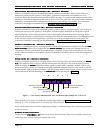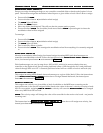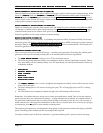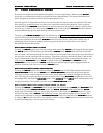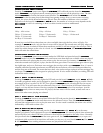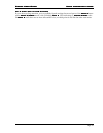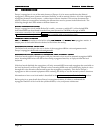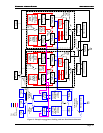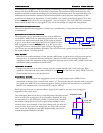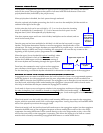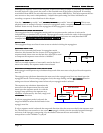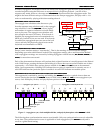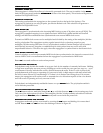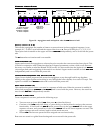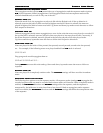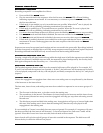
Arpeggiator
ArpeggiatorArpeggiator
Arpeggiator
Europa User Guide
Europa User GuideEuropa User Guide
Europa User Guide
Page 32
Even though the arpeggiator diagram is initially intimidating, Europa’s arpeggiator architecture really is
simple when broken down into its individual components. The interaction between them can be very
simple to extremely complex depending upon the settings and features used. The important thing is to
understand at least the basic interaction between the modules even if the entire functionality of the
modules is not understood. Regardless, it is still possible to be creative with the arpeggiator! Note that
when in SPLIT
SPLITSPLIT
SPLIT mode, there are two arpeggiators – lower and upper. The clock is the only component
that is shared between the two arpeggiators. The rest of the settings are completely independent.
Arpeggiator architecture
Arpeggiator architectureArpeggiator architecture
Arpeggiator architecture
This section describes the arpeggiator’s architecture, systematically, to help make the architecture easier
to understand.
Arpeggiator clocking
Arpeggiator clockingArpeggiator clocking
Arpeggiator clocking sources
sources sources
sources
The arpeggiator can be synchronized to one of three different
clock sources: MIDI Clock, the internally generated clock, or the
external clock input found on the back of the Jupiter 6 (labeled
trigger in on the back of the Jupiter 6). This clock signal is sent to
both arpeggiators when in SPLIT
SPLITSPLIT
SPLIT mode, or to the upper voice
arpeggiator when in whole mode. Upper and lower arpeggiator
sync sources are not independently selectable. The clock sources are a global setting and are saved with
the board NVRAM - not in the presets.
MIDI CLOCK
MIDI CLOCKMIDI CLOCK
MIDI CLOCK
MIDI IN Clock synchronization is a new feature with Europa. It synchronizes at 24 parts per quarter
note (per step – assumes no divider or multiplier). Receipt of a MIDI start message will start the
arpeggiator back to the beginning of the arpeggiation stepping (more on that later!). MIDI Clock is not
transmitted when synchronized to MIDI clock.
INTERNAL CLOCK
INTERNAL CLOCKINTERNAL CLOCK
INTERNAL CLOCK
Europa’s internal clock is far more accurate than the original Roland code’s clock, and exact BPM
speeds are selectable and are accurate within 0.2% (see Figure for the clock rate table). MIDI Clock will
be transmitted when set to the internal clock.
EXTERNAL CLOCK
EXTERNAL CLOCKEXTERNAL CLOCK
EXTERNAL CLOCK
The external clock advances the arpeggiator at a rate of a single step per pulse. MIDI Clock is
transmitted at the rate of the external clock pulses * 12. This assumes that the external clock is one pulse
per eighth note. MIDI Clock and other arpeggiator clocking features will not behave in a predictable
manner if the external clock is not received at a regular interval.
From this point forward, it is assumed that a single clock is equal to one step of the arpeggiator,
regardless of the source clock.
The clock signal (blue line at the top of the diagram to the right) is then
fed in to each of the arpeggiators. If polyrhythm is disabled, the clock
is routed directly to the multiplier/divider. If polyrhythm is enabled,
the number of steps between clocks is equal to the number of notes
currently held. As an example, if one note is being held, one step will
occur per clock. If two notes are being held, two steps will occur per
clock, and so on. Regardless of the polyrhythm setting, the clock is
routed through the multiplier/divider.
MIDI
Clock
Internal
Clock
External
Clock
Sync
source
select
Polyrhythm
Polyrhythm enable
From note
held list



